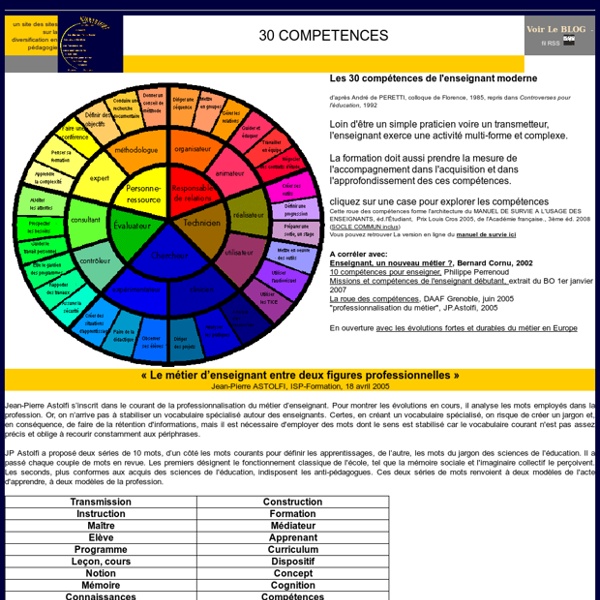



http://francois.muller.free.fr/diversifier/30compet.htm
Related: Débuter comme enseignant • prof_m_roig • mshem • Doc pour enseignants20 Signs You’re Actually Making A Difference As A Teacher Other Data: 20 Signs You’re Actually Making A Difference As A Teacher by Saga Briggs, opencolleges.edu.au You plan. You assess. everything elearning. Instructional Design in Elearning George Siemens September 30, 2002 Introduction Elearning is the marriage of technology and education, and most often, the instructional designer's greatest role is that of "bridging" concepts between the two worlds. HYPERACTIVIT et TROUBLES des APPRENTISSAGES Download Policy: Content on the Website is provided to you AS IS for your information and personal use only and may not be sold or licensed nor shared on other sites. SlideServe reserves the right to change this policy at anytime. While downloading, If for some reason you are not able to download a presentation, the publisher may have deleted the file from their server.
PISA - PISA Teachers are the most important resource in today’s schools. In every country, teachers’ salaries and training represent the greatest share of expenditure in education. And this investment in teachers can have significant returns: research shows that being taught by the best teachers can make a real difference in the learning and life outcomes of otherwise similar students. Teachers, in other words, are not interchangeable workers in some sort of industrial assembly line; individual teachers can change lives – and better teachers are crucial to improving the education that schools provide.
What an Effective Teacher's Classroom Looks Like Another school year is approaching and many novice teachers are preparing to enter their own classrooms for the first time. To help them on their way, MiddleWeb is publishing a series of brief articles offering good advice and food for thought. What We See in Effective and Ineffective Classrooms by Annette Breaux and Todd Whitaker
Fun with learning taxonomies Dave Ferguson’s recent post on Bloom’s learning taxonomy (see Lovin’ Bloom) got me thinking about the value of learning taxonomies in learning and information design. Learning taxonomies attempt to break down and categorize types of learning to help designers (of instruction, information, education, performance) develop objectives and learning strategies best matched to the specific type of learning targeted. They are at the core of most approaches to instructional design.
A Wonderful Poster on Failure July13, 2014 I have always believed that teachers (and people in general) MUST have an open midset; one that tolerates and celebrates mistakes and errors; one that looks at failure as an opportunity for a better beginning. It is through falling down that we stand up robust and it is through misfortunes that we gather our strength to live the life we want and pursue our dreams. If we want to raise up socially and emotionally strong students who can face up and overcome the hardships of life, an important key to this is to teach (and model) them about failure.
Innovating Education with an Educational Modeling Language: Two Case Studies Sloep, Peter B.; van Bruggen, Jan; Tattersall, Colin; Vogten, Hubert; Koper, Rob; Brouns, Francis; van Rosmalen, Peter Innovations in Education and Teaching International, v43 n3 p291-301 Aug 2006 The intent of this study was to investigate how to maximize the chances of success of an educational innovation--specifically one based on the implementation of the educational modeling language called EML. This language is both technically and organizationally demanding. Two different implementation cases were investigated, one situated in an institution for higher professional education that caters for on-campus students; the other in an institution for higher, open distance education, that serves off-campus, home-based students. Diffusion-innovation theory is used as the backdrop for the analysis.
Education Week (This is the last post in a two-part series on this topic. You can see Part One here.) Katie Keeler asked: How do you create a school culture or even classroom culture in which students strive for success and are expected to strive for success? Part One of this series featured responses from educators Jeffrey Benson, Christopher Lehman, and Barbara Blackburn, and I also shared a few of my own thoughts. Instructional Design Models Martin Ryder University of Colorado at Denver School of Education Instructional Design Models Models, like myths and metaphors, help us to make sense of our world. Whether it is derived from whim or from serious research, a model offers its user a means of comprehending an otherwise incomprehensible problem. An instructional design model gives structure and meaning to an I.D. problem, enabling the would-be designer to negotiate her design task with a semblance of conscious understanding.